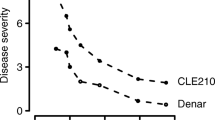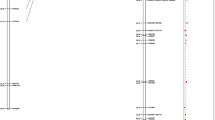Abstract
Cambridge Composite Cross Five (CCV) of barley was studied utilising hordeins, restriction fragment length polymorphisms (RFLPs) and reaction to powdery mildew with a view to understanding the genetic changes occurring in the population. Changes in the frequency of individual hordein patterns as well as pattern combinations showed directional trends in successive generations in three parallel populations maintained as discrete populations since 1977 in Cambridge. Certain hordein pattern combinations were more common in the resistance classes and there was a strong association between hordein patterns and mildew reaction. RFLP analysis revealed that 80% of a random sample taken from generation F24 of Population I had the same restriction pattern as that of the cultivar Algerian, which was one of the original 30 parental lines of CCV. This cultivar is the source of the Mla1 allele in barley improvement programmes in Europe. We argue, based on supporting evidence from hordein analysis and tests of reaction to selected mildew isolates of known virulence isolates together with UK virulence surveys, that selection for Mla1 in Cambridge has been the predominant evolutionary force in CCV in Cambridge.
Similar content being viewed by others
References
Danquah, E.Y., 1993. Natural selection and components of fitness in Composite Cross Five of barley. PhD Thesis. University of Cambridge, UK.
Forde, B.G., M. Kreis, M. Williamson, R.P. Fry, J. Pywell, P.R. Shewry, N. Bunce &; B.J. Miflin, 1985. Short tandem repeats shared by B-and C-hordein cDNAs suggest a common evolutionary origin for two groups of cereal protein genes. EMBO J. 4: 9.
Ibrahim, K.M. &; J.A. Barrett, 1991. Evolution of mildew resistance in a hybrid bulk population of barley. Heredity 67: 247–256.
Ibrahim, K.A., J.B.R. Hayter &; J.A. Barrett, 1996. Frequency changes in storage protein genes in a bulk population of barley. Heredity 77: 231–239.
Jain, S.K.&; R.W. Allard, 1960. Population studies in predominantly self-pollinated species. I. Evidence of heterozygote advantage in a closed population of barley. Proc. Nat. Acad. Sci. USA 46: 1371–1377.
Jensen, J., J.H. Jorgensen, H. Jensen &; H. Doll, 1980. Linkage of the hordein loci Hor1 and Hor2 with the powdery mildew resistance loci Ml-k and Ml-a on barley chromosome 5. Theoret. Appl. Genet. 58: 27–31.
Luckett, D.J. &; K.J.R. Edwards, 1986. Esterase genes in parallel composite cross barley populations. Genetics 114: 289–302.
Luckett, D.J. &; A.L. Shariff, 1987. Metrical characters in parallelgrown sub-populations of barley Composite Cross Five. Aust. J. Biol. Sci. 40: 65–77.
Murray, M. &; W.F. Thompson, 1980. Rapid isolation of highmolecular-weight plant DNA. Nucl. Acids Res. 8: 4321–4325.
Nei, M., 1973. Analysis of genetic diversity in subdivided populations. Proc. Nat. Acad. Sci. USA 70: 3321–3323.
Shewry, P.R., H.M. Pratt &; B.J. Miflin, 1978. Varietal identification of single seeds of barley by analysis of hordein polypeptides. J. Sci. Food Agric. 29: 587–596.
Shewry, P.R., M.S. Wolfe, S.E. Slater, S.R. Parmar, A.J. Faulks &; B.J. Miflin, 1981. Barley storage proteins in relation to varietal identification, malting quality and mildew resistance, pp. 596–603 in Barley Genetics IV. Proceedings of the Fourth International Barley Genetics Symposium, edited by M.J.C. Asher, R.P. Ellis, A.M. Hayter &; R.N.H. Whitehouse. Edinburgh University Press, Edinburgh.
Shewry, P.R., B.J. Miflin &; D.D. Kasarda, 1984. The structural and evolutionary relationship of the prolamin storage proteins of barley, rye and wheat. Philos. Trans. R. Soc. (London) Ser. B 304: 297–308.
Shewry, P.R., N.A.C. Bunce, M. Kreis &; B.G. Forde, 1985. Polymorphism at the Hor1 locus of barley (Hordeum vulgare L.). Biochem. Genet. 23: 391–404.
Smith, D.B. &; P.I. Payne, 1984. A procedure for the routine determination of electrophoretic band patterns of barley and malt endosperm proteins. J. Nat. Inst. Agric. Bot. 16: 487–498.
Suneson, C.A., 1956. An evolutionary plant breeding method. Agron. J. 48: 188–191.
UK virulence surveys, 1978-1992. United Kingdom Cereal Pathogen Virulence Survey Annual Reports for 1978-1992.
Author information
Authors and Affiliations
Rights and permissions
About this article
Cite this article
Danquah, E., Barrett, J. Evidence of Natural Selection for Disease Resistance in Composite Cross Five (CCV) of Barley. Genetica 115, 195–203 (2002). https://doi.org/10.1023/A:1020178310448
Issue Date:
DOI: https://doi.org/10.1023/A:1020178310448




